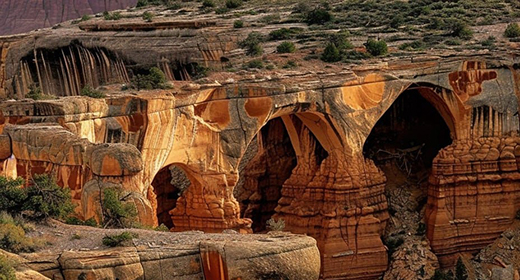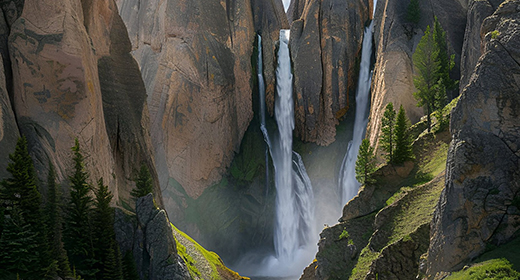by Jo deVries: The transformation of the landscape over the four seasons in Canada is dramatic…
Autumn is presently in in full bloom. The leaves of the maple trees are aglow, the evenings are cooler, the air fresher. The bathing suits have been packed away, and most vacationers have left this part of cottage country except for a few that return for Thanksgiving. Hopefully, we’ll be able to leave out the lawn chairs for another month or so. This has been one of the best fall seasons in memory, temperature wise. There’s still no hint of frost in the forecast.
Country Road Fall Drives
I’ve been fortunate enough to enjoy a few long, country drives over the past week. I can drive for hours in any direction and still be surrounded by the glorious autumn colours, mingled with magnificent rock outcroppings, wide-open wetlands, and areas of dense, dark, evergreen forests. The spectacular show of the autumn leaves draped over miles of rolling hills is stunning. The green, yellow, orange and red leaves against a backdrop of varying shades of blue and grey creates an ever-changing masterpiece of exceptional design.
As always, the show will only last a short time, so I made it a priority this year to absorb as much of that beauty as I could. Thankfully, with the advantage of photography, I can enjoy those spectacular sights for years to come.
I am so incredibly grateful for my blessings, and the era of which I am living in. What a luxury to jump in the car, visit briefly with distant friends, pick up groceries somewhere new, and simply enjoy the splendid sights during a six-hour road trip on the back highways.
Putting Pigs to Work
My leisure time is somewhat limited at this time of year, so my outings are restricted. I have two demanding pigs and can only leave the farm between feeding times, lest they get the idea to dig their way to freedom.
The elderberry grove that the pigs have been clearing is looking better now that we’ve finally had some rain. The pigs found it difficult to dig in that area during the hot summer months due to a third year of drought but have made up for lost time in the last couple of weeks. The soil has had a good going-over, and most of the field is bare save for the elderberry.
Next February, I will cut back the aging elderberry stalks and put them in water. In the spring, I will plant the newly rooted canes in the prepared field.

The pigs helped clear the field allotted to elderberry.
Photo by Jo deVries
Technology on the Homestead
I learned everything I needed to know about elderberry from magazines and the Internet. What a time-saver to learn from other people’s experiences!
We enjoy many conveniences in this day and age. In the past, people were more likely to do what everyone around them did, knowing very little about alternative ideas. Nowadays, people from around the globe can easily share data, plans, and photos within seconds. Having access to a world of information in the palm of our hands is remarkable. Even knowing the approximate weather conditions coming our way is invaluable.
There are tools at our disposal that people only dreamed of a hundred years ago and a mind-boggling array of materials to choose from. Our generation has the benefit of all the information from previous successful building concepts and can add to it many modern conveniences and practical updates. Windows, mirrors, and skylights are items that drastically changed the construction industry, and now we can have them delivered to our door.
In combining the old and the new, we can design and create durable, practical, beautiful, sustainable buildings that will last for generations. That is my long-term goal. In the meantime, I’m starting to wrap things up for another season; snow could appear in as little as a few weeks.
Building a Living Roof Greenhouse
My present building project, and first living-roof endeavour is a small greenhouse adjacent to my chicken coop. The excavation job, which I’m doing by hand, will involve at least another 20 hours. I hope to put the foundation in next spring. Should I win the lottery, and this great weather continue, it might be done sooner.
Chicken Woes
My chickens had a rough time this year. Mid-season, predators killed my purebred Silkie rooster and one hen. That meant that I could only hatch mixed-breed chicks, which are not as easy to sell as purebreds. I decided to discontinue my breeding program for this year. Then my friend accidently cooked two dozen eggs in her incubator. Hey, stuff happens.
A couple of months later, six of the chicks I had hatched were killed by predators. I don’t know exactly what killed them, but the list of predators in these parts is endless. I have since replenished my breeding stock, and all is well.
Rural Living Offers Perspective
I know that my decision to move to a rural area and develop a piece of inexpensive bush land was the smartest decision I have ever made. Being surrounded by nature is the healthiest environment in which to stay grounded in. Viewing the world from a distance has many advantages. It’s easier to think clearer if one is outdoors in the fresh air, away from the many distractions that bombard our lives.
After living in the bush for 20 years, I have spent countless hours thinking about how our environments shape who we are. I am constantly reviewing my actions, renouncing unhealthy learned behaviours, and streamlining my practices. I am on a quest of learning what it means to live off the land and considering the various ways I might achieve sustainability and independence.
It is our society’s reliance on gasoline and electricity that scared me into rethinking things. To pass that kind of a lifestyle on to my son just seemed wrong. I wanted to give my descendants the opportunity to live a healthier, happier, and more secure existence. Working the land brings satisfaction to the soul in the short term and sustenance in due time. It enables one to fill photo albums of developments, achievements, and memories and most importantly, leaves a trail for others to follow.
Homesteading Requires a Long-Term Vision
Changing this plot of land into a sustainable farm is a lifelong commitment. I’m working with a long-term plan in mind. I’m imagining what the place will look like in years to come and inching my way in that direction.
Many of the trees will not be fully matured until I’m long gone, and I’m at peace with that. Some of the trees on my property were here before I existed and will still be alive when my son is gone. I am just glad to have stood in their shade for a time. This is God’s country, and I consider it an honour to be caretaker of a small piece of it. Living close to nature is an existence that I will forever be grateful for.
If you have not yet tried it, I strongly recommend taking the leap. This planet is our most valuable asset and real estate is always a solid investment.










































